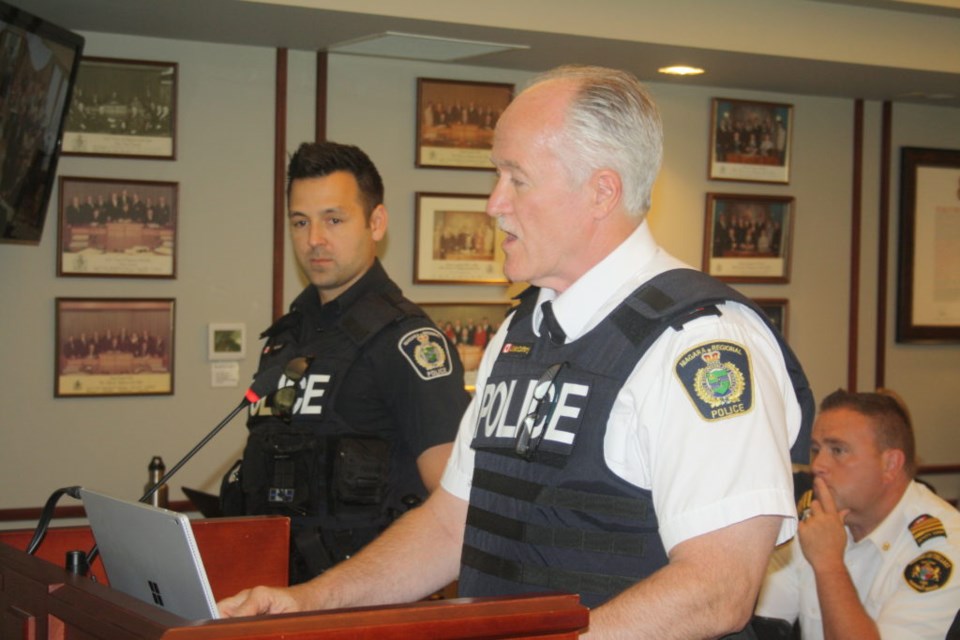
In an update on the challenges presented by horse and carriage protesters and supporters, Insp James McCaffery of the Niagara Regional Police told council Monday he couldn’t share any information about ongoing negotiations.
“It’s imperative we maintain our neutrality in this situation,” so police can continue discussions with both sides, he said.
The job of the police is to ensure protestors “enjoy their lawful rights,” to develop a protocol that works for both sides and to be onsite to keep the peace if necessary, said McCaffery.
“We’ve endeavoured to maintain a working relationship with the two groups of protesters and the Town,” he said.
He went over the history of the police involvement, beginning in June, 2018, and leading to the establishment of a protocol worked out with representatives from both sides and from the Town.
The goal of the protocol is to allow for the free and safe flow of traffic, and to maintain peace and order. It was agreed that the two groups would keep six feet away from each other, and the horse protesters, members of At War For Animals Niagara, would stay 10 feet away from the horse-drawn carriages. There was also to be no conversation between the two groups.
Members of both sides were in the council chamber to hear McCaffery.
There have been “minor infractions” dealt with in the last year, he said, adding the protocol loses its strength when those involved don’t agree to it.
He gave a bit of background information about the June 29 incident when police were called to the Cenotaph because protesters were using it to project videos of their speciesism message, which is that humans should not be using animals for their benefit.
He spoke of the great respect police have for veterans, and said on review of the details with the Crown Attorney it was determined the intent of the group was educational, not to cause damage to the war memorial.
“It didn’t meet the bar for criminality,” said McCaffery.
Since then, NRP protest liaison officers have continued to work with both groups and are trying to get all parties back to the table to review the protocol, which is not enforceable by law.
He reminded council that a peaceful protest on public property is lawful and constitutionally protected by the Canadian Charter of Rights, and although there are limits to what is allowed in certain circumstances, “to date that hasn’t happened.”
Const. Mike Malachowsky, an NRP protest liaison officer, was also at council Monday to respond to some comments he’s heard and read about methods to control protests, and said so far he has found nothing that could help the Town. He has researched three cities, Toronto, Mississauga and Ottawa, “the hub of most demonstrations,” and said he has found there are no permits or bylaws to limit or control protesting. There are applications groups can fill out “as a courtesy” to let a town or city know they plan a protest or demonstration, but they’re not mandatory, he said.
“The City of Ottawa has plenty of protests all the time, but there are no bylaws specific to demonstrations.” There are many groups that do fill out the courtesy document, “and many that don’t,” he said.
Ken Gansel, chair of the Niagara Police Services Board, was onhand to talk about the NRP’s camera program municipalities can link to.
A real-time operation centre is operated 24/7, he said, and although there isn’t someone watching the video monitors, the evidence is there if necessary. A number of municipalities have chosen to join it for increased public and community safety, and there are private enterprises which also share their video with the NRP system.
“This is a crime-prevention program,” he said, and “an after-the-fact tool for police. It’s a worthwhile project here in Niagara.”
In response to several questions from councillors as to their role when residents have complaints or concerns — specific situations were mentioned, such as protesters on private property, hate speech on social media, people being intimidated, and a concern about inappropriate filming — McCaffery stressed each situation is different, and police should be notified to allow them to decide appropriate action in each circumstance.
“Call us. We’ll make that determination,” he said.